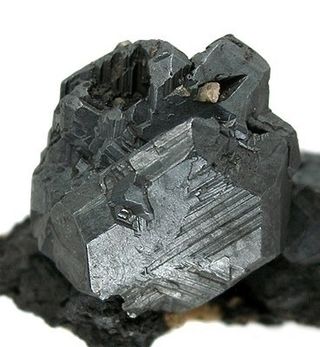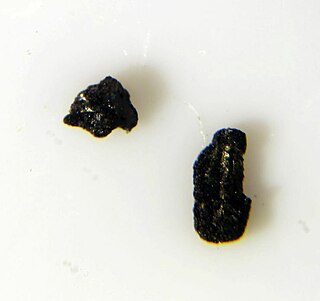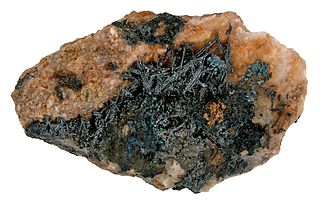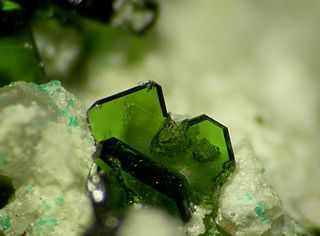
Rhenium is a chemical element with the symbol Re and atomic number 75. It is a silvery-gray, heavy, third-row transition metal in group 7 of the periodic table. With an estimated average concentration of 1 part per billion (ppb), rhenium is one of the rarest elements in the Earth's crust. Rhenium has the third-highest melting point and highest boiling point of any stable element at 5869 K. Rhenium resembles manganese and technetium chemically and is mainly obtained as a by-product of the extraction and refinement of molybdenum and copper ores. Rhenium shows in its compounds a wide variety of oxidation states ranging from −1 to +7.

Chalcopyrite ( KAL-kə-PY-ryte, -koh-) is a copper iron sulfide mineral and the most abundant copper ore mineral. It has the chemical formula CuFeS2 and crystallizes in the tetragonal system. It has a brassy to golden yellow color and a hardness of 3.5 to 4 on the Mohs scale. Its streak is diagnostic as green-tinged black.

Bornite, also known as peacock ore, is a sulfide mineral with chemical composition Cu5FeS4 that crystallizes in the orthorhombic system (pseudo-cubic).

Molybdenite is a mineral of molybdenum disulfide, MoS2. Similar in appearance and feel to graphite, molybdenite has a lubricating effect that is a consequence of its layered structure. The atomic structure consists of a sheet of molybdenum atoms sandwiched between sheets of sulfur atoms. The Mo-S bonds are strong, but the interaction between the sulfur atoms at the top and bottom of separate sandwich-like tri-layers is weak, resulting in easy slippage as well as cleavage planes. Molybdenite crystallizes in the hexagonal crystal system as the common polytype 2H and also in the trigonal system as the 3R polytype.

Chalcocite, copper(I) sulfide (Cu2S), is an important copper ore mineral. It is opaque and dark gray to black, with a metallic luster. It has a hardness of 2.5–3 on the Mohs scale. It is a sulfide with a monoclinic crystal system.

Iturup is one of the Kuril Islands. It was formerly known as Staten Island. It is the largest and northernmost island in the southern Kurils, ownership of which is disputed by Japan and Russia.

The sulfide minerals are a class of minerals containing sulfide (S2−) or disulfide (S22−) as the major anion. Some sulfide minerals are economically important as metal ores. The sulfide class also includes the selenides, the tellurides, the arsenides, the antimonides, the bismuthinides, the sulfarsenides and the sulfosalts. Sulfide minerals are inorganic compounds.

Berryite is a mineral with the formula Pb3(Ag,Cu)5Bi7S16. It occurs as gray to blue-gray monoclinic prisms. It is opaque and has a metallic luster. It has a Mohs hardness of 3.5 and a specific gravity of 6.7.

Stilleite is a selenide mineral, zinc selenide, with the formula ZnSe. It has been found only as microscopic gray crystals occurring as inclusions in linnaeite associated with other selenide and sulfides. It was originally discovered in Katanga Province, Zaire in 1956 and is named for the German geologist, Hans Stille (1876–1966).

Stromeyerite is a sulfide mineral of copper and silver, with the chemical formula AgCuS. It forms opaque blue grey to dark blue orthorhombic crystals.

Digenite is a copper sulfide mineral with formula: Cu9S5. Digenite is a black to dark blue opaque mineral that crystallizes with a trigonal - hexagonal scalenohedral structure. In habit it is usually massive, but does often show pseudo-cubic forms. It has poor to indistinct cleavage and a brittle fracture. It has a Mohs hardness of 2.5 to 3 and a specific gravity of 5.6. It is found in copper sulfide deposits of both primary and supergene occurrences. It is typically associated with and often intergrown with chalcocite, covellite, djurleite, bornite, chalcopyrite and pyrite. The type locality is Sangerhausen, Thuringia, Germany, in copper slate deposits.

Medvezhya (Russian: Медве́жий; Japanese: 茂世路岳, Moyoro-dake) is a volcanic complex located at the northern end of Iturup Island, Kuril Islands, Russia. Rheniite, a rhenium sulfide mineral (ReS2), was discovered and approved in 2004. It is found in active hot fumaroles on the volcano.

Roscoelite is a green mineral from the mica group that contains vanadium.

Drysdallite is a rare molybdenum selenium sulfide mineral with formula Mo(Se,S)2. It crystallizes in the hexagonal system as small pyramidal crystals or in cleavable masses. It is an opaque metallic mineral with a Mohs hardness of 1 to 1.5 and a specific gravity of 6.25. Like molybdenite it is pliable with perfect cleavage.

Gilalite is a copper silicate mineral with chemical composition of Cu5Si6O17·7(H2O).

Abramovite is a very rare mineral from the sulfides and sulfosalt categories. It has the chemical formula Pb2SnInBiS7. It occurs as tiny elongated lamellar-shaped crystals, up 1 mm × 0.2 mm in size, and is characterized by its non-commensurate structure.

Jalpaite is a rare copper silver sulfide mineral with formula Ag3CuS2.

Stannoidite is a sulfide mineral composed of five chemical elements: copper, iron, zinc, tin and sulfur. Its name originates from Latin stannum (tin) and Greek eides. The mineral is found in hydrothermal Cu-Sn deposits.

The mineral uytenbogaardtite, Ag3AuS2, is a soft, greyish white sulfide mineral, occurring in hydrothermal Au-Ag-quartz veins. It occurs as tiny crystals, visible only with a microscope. It has a metallic luster and a hardness on the Mohs scale of 2 (gypsum).

Lindgrenite is an uncommon copper molybdate mineral with formula: Cu3(MoO4)2(OH)2. It occurs as tabular to platey monoclinic green to yellow green crystals.




















